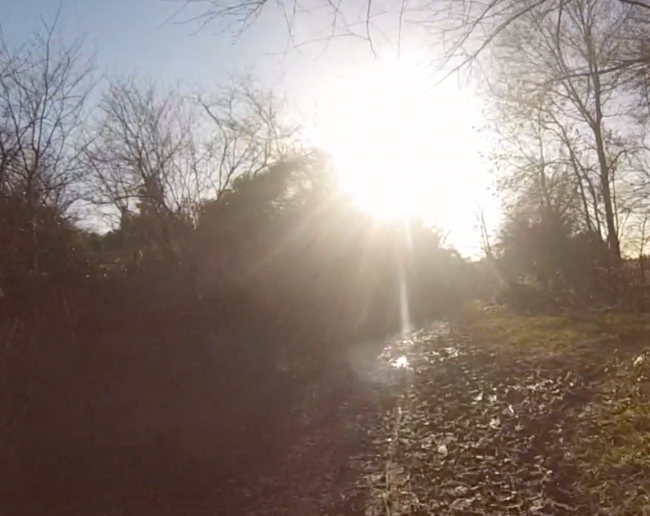Above: a still from one of my first GoPro videos: Hodgemoor Wood, Bucks
Way back in 1998, I cycled at speed down a Normandy valley wishing I could have videoed the experience. Some 15 years on, I have the answer: the GoPro Hero 3 video camera. I’m still learning how to make the most of it, but I love this clever bit of kit, which brings together two of my passions, cycling and video.
I usually edit my videos on my Mac with Apple’s iMovie app. All the reports I’d read suggested that GoPro videos needed converting from MPEG 4 to a format iMovie can handle. But the first time I tried importing directly, iMovie seemed to handle everything fine without converting. But then I ran into difficulties. I had to cancel the first import – and couldn’t get the Mac to resume. (It wouldn’t do anything without the camera being connected.) I had no better luck the second time. So today, I bit the bullet, and converted my latest video footage in GoPro Studio before attempting to edit it in iMovie. It worked flawlessly.
So my best tip for anyone else wanting to edit GoPro footage in iMovie is this: accept you need to convert the footage first. You’ll save yourself a lot of frustration.
I’ll end with one last still from my Hodgemoor video. There’s nothing better on a wet and windy evening than reliving a wonderful sunny day on the bike. I wish I’d had this for my 2002 Land’s End to John O’Groats ride…
Here’s the Hodgemoor Wood video:
PS: read my review of the GoPro jaws clamp mount.



Hey Rob,
Nice video of a nice area. A friend of mine lives in Amersham.
I’ve now moved to using Final Cut Pro X for my video editing after I spent an age on one project in iMovie, which required some fiddly synchronisation of audio tracks from one camera with footage from another. I was also experimenting with using my Hero 3 to give a first-person point of view in some of the shots – this one:
The GoPro records in MPEG-4 and outputs .mp4 files, which are a final delivery format. Hence editing software like iMovie and FCPX don’t like it. You can’t import it directly into FCPX either.
The trick I discovered for GoPro footage is that you can import directly from camera (or the card if you tell the program it’s the camera), whereas if you transfer the files to your HD then try to import them, it doesn’t work. But if imported directly from camera to iMovie, I can then import the iMovie event to FCPX with no trouble.
An alternative is to use Clipwrap to wrap them into .mov format (which I’ve done with some old compact camera videos).
I think I’m also going to investigate Pavtube.
Anwyay enough video nerdery. It’s what you can do with it that counts. My most successful use of the Hero 3 yet was our River Spey canoe trip here:
If you don’t have a vented helmet strap for shooting while cycling, you might want to consider it. I find it works well.
Cheers,
Paul
Thanks for your comment and videos Paul! Appreciate it. I loved the videos and your tips. I have a vented helmet and agree it’s great for the GoPro.
Hi Rob,
An extra tip for you on using GoPros – I’ve now had two 64GB Micro SD cards corrupted by my GoPro Hero 3. In both cases I was on wilderness trips and lost valuable footage. In contrast, I’ve had absolutely no problem with 16GB or 32GB cards. I’ve Googled this problem and it seems I’m not the only one.
Just thought I’d give you a heads up.
All the best,
Paul
Great advice Paul – thank you! I’m always a little nervous of cards after a camera card failed while I was shooting a dramatic parachute drop from a Hercules in Dorset in 2010. I lost all the images.
Pingback: Two years blogging at WordPress.com | Ertblog
Pingback: Testing the GoPro jaws clamp mount | Ertblog
1080/60/protune makes for some nice footage! Have to import and convert with GoPro Studio but then it’s ready to import to iMovie. Software isn’t the problem, it’s 2007 hardware! This is the year I get a new machine
Pingback: Ertblog: 10 years a blogger | Ertblog